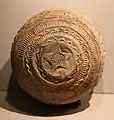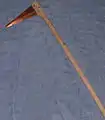Bell Beaker culture
The Bell Beaker culture (also described as the Bell Beaker complex or Bell Beaker phenomenon) is an archaeological culture named after the inverted-bell beaker drinking vessel used at the very beginning of the European Bronze Age. Arising from around 2800 BC, it lasted in Britain until as late as 1800 BC[1][2] but in continental Europe only until 2300 BC, when it was succeeded by the Unetice culture. The culture was widely dispersed throughout Western Europe, being present in many regions of Iberia and stretching eastward to the Danubian plains, and northward to the islands of Great Britain and Ireland, and was also present in the islands of Sicily and Sardinia and some small coastal areas in north-western Africa. The Bell Beaker phenomenon shows substantial regional variation, and a study[3] from 2018 found that it was associated with genetically diverse populations.
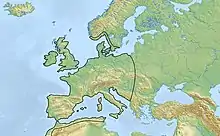 Distribution of the area of influence of the Bell Beaker culture | |
| Geographical range | Europe |
|---|---|
| Period | Chalcolithic – Early Bronze Age |
| Dates | c. 2800–1800 BC |
| Major sites | Castro of Zambujal |
| Preceded by | Corded Ware culture, Yamnaya culture, Funnelbeaker culture, Neolithic British Isles, Neolithic France, Seine-Oise-Marne culture, Chalcolithic Iberia, Chalcolithic Italy |
| Followed by | Únětice culture, Bronze Age Britain, Armorican Tumulus culture, Rhône culture, Nordic Bronze Age, Argaric culture, Polada culture, Bronze Age Ireland, Hilversum culture, Elp culture, Atlantic Bronze Age |
| Bronze Age |
| Part of a series on |
| Indo-European topics |
|---|
 |
The Bell Beaker culture was partly preceded by and contemporaneous with the Corded Ware culture, and in north-central Europe preceded by the Funnelbeaker culture. The name Glockenbecher was coined for its distinctive style of beakers by Paul Reinecke in 1900. The term's English translation Bell Beaker was introduced by John Abercromby in 1904.[4]
In its early phase, the Bell Beaker culture can be seen as the western contemporary of the Corded Ware culture of Central Europe. From about 2400 BC the Beaker folk culture expanded eastwards, into the Corded Ware horizon.[5] In parts of Central and Eastern Europe, as far east as Poland, a sequence occurs from Corded Ware to Bell Beaker.
This period marks a period of cultural contact in Atlantic and Western Europe following a prolonged period of relative isolation during the Neolithic.
In its mature phase, the Bell Beaker culture is understood as not only a collection of characteristic artefact types, but a complex cultural phenomenon involving metalwork in copper and gold, long-distance exchange networks, archery, specific types of ornamentation, and (presumably) shared ideological, cultural and religious ideas, as well as social stratification and the emergence of regional elites.[6][7] A wide range of regional diversity persists within the widespread late Beaker culture, particularly in local burial styles (including incidences of cremation rather than burial), housing styles, economic profile, and local ceramic wares (Begleitkeramik). Nonetheless, according to Lemercier (2018) the mature phase of the Beaker culture represents "the appearance of a kind of Bell Beaker civilization of continental scale."[8]
Origins and expansion
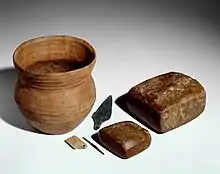
Origins
The Bell Beaker artefacts (at least in their early phase) are not distributed across a contiguous area, as is usual for archaeological cultures, but are found in insular concentrations scattered across Europe. Their presence is not associated with a characteristic type of architecture or of burial customs. However, the Bell Beaker culture does appear to coalesce into a coherent archaeological culture in its later phase.
The origin of the "Bell Beaker" artefacts has been traced to the early 3rd millennium, with early examples of the "maritime" Bell Beaker design having been found at the Tagus estuary in Portugal, radiocarbon dated to c. the 28th century BC.[2][9][10] The inspiration for the Maritime Bell Beaker is argued to have been the small and earlier Copoz beakers that have impressed decoration and which are found widely around the Tagus estuary in Portugal.[11] Turek sees late Neolithic precursors in northern Africa, arguing the Maritime style emerged as a result of seaborne contacts between Iberia and Morocco in the first half of the third millennium BC.[12]
More recent analyses of the "Beaker phenomenon", published since the 2000s, have persisted in describing the origin of the "Beaker phenomenon" as arising from a synthesis of elements, representing "an idea and style uniting different regions with different cultural traditions and background."[13][14]
Expansion and Corded Ware contacts
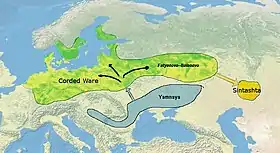
The initial moves from the Tagus estuary were maritime. A southern move led to the Mediterranean where 'enclaves' were established in south-western Spain and southern France around the Golfe du Lion and into the Po Valley in Italy, probably via ancient western Alpine trade routes used to distribute jadeite axes. A northern move incorporated the southern coast of Armorica. The enclave established in southern Brittany was linked closely to the riverine and landward route, via the Loire, and across the Gâtinais Valley to the Seine Valley, and thence to the lower Rhine. This was a long-established route reflected in early stone axe distributions, and via this network, Maritime Bell Beakers first reached the Lower Rhine in about 2600 BC.[2][15]
Another expansion brought Bell Beaker to Csepel Island in Hungary by about 2500 BC. In the Carpathian Basin, the Bell Beaker culture came in contact with communities such as the Vučedol culture (c. 3000–2200 BC), which had evolved partly from the Yamnaya culture (c. 3300–2600 BC).[note 1] In contrast to the early Bell Beaker preference for the dagger and bow, the favourite weapon in the Carpathian Basin during the first half of the third millennium was the shaft-hole axe.[17] Here, Bell Beaker people assimilated local pottery forms such as the polypod cup. These "common ware" types of pottery then spread in association with the classic bell beaker.[18]
The Rhine was on the western edge of the vast Corded Ware zone (c. 3100–2350 BC), forming a contact zone with the Bell Beaker culture. From there, the Bell Beaker culture spread further into Eastern Europe, replacing the Corded Ware culture up to the Vistula (Poland).[19][note 2]
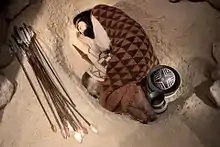
A review in 2014 revealed that single burial, communal burial, and reuse of Neolithic burial sites are found throughout the Bell Beaker zone.[21] This overturns a previous conviction that single burial was unknown in the early or southern Bell Beaker zone, and so must have been adopted from Corded Ware in the contact zone of the Lower Rhine, and transmitted westwards along the exchange networks from the Rhine to the Loire,[22][23] and northwards across the English Channel to Britain.[2][24]
The earliest copper production in Ireland, identified at Ross Island in the period 2400–2200 BC, was associated with early Beaker pottery.[2][25] Here, the local sulpharsenide ores were smelted to produce the first copper axes used in Britain and Ireland.[2] The same technologies were used in the Tagus region and in the west and south of France.[2][26] The evidence is sufficient to support the suggestion that the initial spread of Maritime Bell Beakers along the Atlantic and into the Mediterranean, using sea routes that had long been in operation, was directly associated with the quest for copper and other rare raw materials.[2]
Migration vs. acculturation
While Bell Beaker (Glockenbecher) was introduced as a term for the artefact type at the beginning of the 20th century, recognition of an archaeological Bell Beaker culture has long been controversial. Its spread has been one of the central questions of the migrationism vs. diffusionism debate in 20th-century archaeology, variously described as due to migration, possibly of small groups of warriors, craftsmen or traders, or due to the diffusion of ideas and object exchange.[27]
Migration
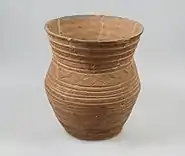
Given the unusual form and fabric of Beaker pottery, and its abrupt appearance in the archaeological record, along with a characteristic group of other artefacts, known as the Bell Beaker "package", the explanation for the Beaker culture until the last decades of the 20th century was to interpret it as the migration of one group of people across Europe.
Gordon Childe interpreted the presence of its characteristic artefact as the intrusion of "missionaries" expanding from Iberia along the Atlantic coast, spreading knowledge of copper metallurgy. Stephen Shennan interpreted the artefacts as belonging to a mobile cultural elite imposing itself over the indigenous substrate populations. Similarly, Sangmeister (1972) interpreted the "Beaker folk" (Glockenbecherleute) as small groups of highly mobile traders and artisans. Christian Strahm (1995) used the term "Bell Beaker phenomenon" (Glockenbecher-Phänomen) as a compromise in order to avoid the term "culture".[28]
Heyd (1998) concluded that the Bell Beaker culture was intrusive to southern Germany, and existed contemporarily with the local Corded Ware culture.[29]
The burial ritual which typified Bell Beaker sites appears to be intrusive to Western Europe, from Central Europe. Individual inhumations, often under tumuli with the inclusion of weapons contrast markedly to the preceding Neolithic traditions of often collective, weaponless burials in Atlantic/Western Europe. Such an arrangement is rather derivative of Corded Ware traditions.[12]
Cultural diffusion
British and American archaeology since the 1960s have been sceptical about prehistoric migration in general, so the idea of "Bell Beaker Folk" lost ground. A theory of cultural contact de-emphasizing population movement was presented by Colin Burgess and Stephen Shennan in the mid-1970s.[30]
Under the "pots, not people" theory, the Beaker culture is seen as a 'package' of knowledge (including religious beliefs, as well as methods of copper, bronze, and gold working) and artefacts (including copper daggers, v-perforated buttons, and stone wrist-guards) adopted and adapted by the indigenous peoples of Europe to varying degrees. This new knowledge may have come about by any combination of population movements and cultural contact. An example might be as part of a prestige cult related to the production and consumption of beer, or trading links such as those demonstrated by finds made along the seaways of Atlantic Europe. Palynological studies including analysis of pollen, associated with the spread of beakers, certainly suggests increased growing of barley, which may be associated with beer brewing. Noting the distribution of Beakers was highest in areas of transport routes, including fording sites, river valleys and mountain passes, Beaker 'folk' were suggested to be originally bronze traders, who subsequently settled within local Neolithic or early Chalcolithic cultures, creating local styles. Close analysis of the bronze tools associated with beaker use suggests an early Iberian source for the copper, followed subsequently by Central European and Bohemian ores.
AOO and AOC Beakers appear to have evolved continually from a pre-Beaker period in the lower Rhine and North Sea regions, at least for Northern and Central Europe.[31]
Renewed emphasis on migration
|
Investigations in the Mediterranean and France recently moved the discussion to re-emphasise the importance of migration to the Bell Beaker story. Instead of being pictured as a fashion or a simple diffusion of objects and their use, the investigation of over 300 sites showed that human groups actually moved in a process that involved explorations, contacts, settlement, diffusion, and acculturation/assimilation. Some elements show the influence from the north and east, and other elements reveal the south-east of France to be an important crossroad on an important route of communication and exchange spreading north. A distinctive 'barbed wire' pottery decoration is thought to have migrated through central Italy first. The pattern of movements was diverse and complicated, along the Atlantic coast and the northern Mediterranean coast, and sometimes also far inland. The prominent central role of Portugal in the region and the quality of the pottery all across Europe are forwarded as arguments for a new interpretation that denies an ideological dimension.[32]
Genetic findings also lend support to the migratory hypothesis. Price et al. (1998), in a strontium isotope analysis of 86 people from Bell Beaker graves in Bavaria, suggest that 18–25% of all graves were occupied by people who came from a considerable distance outside the area. This was true of children and adults, indicative of some significant migration wave. Given the similarities with readings from people living on loess soils, the general direction of the local movement, according to Price et al., is from the northeast to the southwest.[33]
Archaeogenetics studies of the 2010s have been able to resolve the "migrationist vs. diffusionist" question to some extent. The study by Olalde et al. (2017) found only "limited genetic affinity" between individuals associated with the Beaker complex in Iberia and in Central Europe, suggesting that migration played a limited role in its early spread. However, the same study found that the further dissemination of the mature Beaker complex was very strongly linked to migration. This is true especially for Britain, where the spread of the Beaker culture introduced high levels of steppe-related ancestry, resulting in a near-complete transformation of the local gene pool within a few centuries, to the point of replacement of about 90% of the local Neolithic-derived lineages.[34]
Bell Beaker artifacts
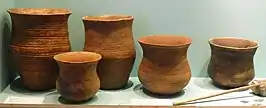
The two main international bell beaker styles are: the All Over Ornamented (AOO), patterned all over with impressions, of which a subset is the All Over Corded (AOC), patterned with cord-impressions, and the Maritime type, decorated with bands filled with impressions made with a comb or cord. Later, other characteristic regional styles developed.[35]
The beakers are suggested to have been designed for the consumption of alcohol, and the introduction of the substance to Europe may have fuelled the beakers' spread.[36] Beer and mead content have been identified from certain examples. However, not all Beakers were drinking cups. Some were used as reduction pots to smelt copper ores, others have some organic residues associated with food, and still others were employed as funerary urns.[37] They were used as status display amongst disparate elites.
Postulated linguistic connections
As the Beaker culture left no written records, all theories regarding the language or languages they spoke remain conjectural. It has been suggested as a candidate for an early Indo-European culture, or as the origin of the Vasconic substrate.
James Mallory (2013) notes that the Beaker culture was associated with a hypothetical cluster of Indo-European dialects termed "North-West Indo-European," a cluster which includes the (predecessors of) Celtic, Italic, Germanic and Balto-Slavic branches.[38]
Earlier theories suggested a link to the hypothesised Italo-Celtic, or Proto-Celtic languages.[39]
Physical anthropology

Historical craniometric studies found that the Beaker people appeared to be of a different physical type than those earlier populations in the same geographic areas. They were described as tall, heavy boned and brachycephalic. The early studies on the Beakers which were based on the analysis of their skeletal remains, were craniometric. This apparent evidence of migration was in line with archaeological discoveries linking Beaker culture to new farming techniques, mortuary practices, copper-working skills, and other cultural innovations. However, such evidence from skeletal remains was brushed aside as a new movement developed in archaeology from the 1960s, which stressed cultural continuity. Anti-migrationist authors either paid little attention to skeletal evidence or argued that differences could be explained by environmental and cultural influences. Margaret Cox and Simon Mays sum up the position: "Although it can hardly be said that craniometric data provide an unequivocal answer to the problem of the Beaker folk, the balance of the evidence would at present seem to favour a migration hypothesis."[40]
Non-metrical research concerning the Beaker people in Britain also cautiously pointed in the direction of migration.[41] Subsequent studies, such as one concerning the Carpathian Basin,[42] and a non-metrical analysis of skeletons in central-southern Germany,[43] have also identified marked typological differences with the pre-Beaker inhabitants.
Jocelyne Desideri examined the teeth in skeletons from Bell Beaker sites in Northern Spain, Southern France, Switzerland, the Czech Republic and Hungary. Examining dental characteristics that have been independently shown to correlate with genetic relatedness, she found that only in Northern Spain and the Czech Republic were there demonstrable links between immediately previous populations and Bell Beaker populations. Elsewhere there was a discontinuity.[44]
Genetics
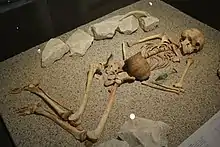
Lee et al. (2012) detected R1b two male skeletons from a German Bell Beaker site dated to 2600–2500 BC at Kromsdorf, one of which tested positive for M269 but negative for its U106 subclade (note that the P312 subclade was not tested for), while for the other skeleton the M269 test was unclear.[45]
Haak et al. (2015) analyzed the remains of a later Bell Beaker male skeleton from Quedlinburg, Germany, dated to 2296–2206 BC. The individual carried haplogroup R1b1a2a1a2 (R-P312). The study found that the Bell Beakers and people of the Unetice culture had less ancestry from the Yamnaya culture than from the earlier Corded Ware culture. The authors took this to be a sign of a resurgence of the indigenous inhabitants of Western Europe in the aftermath of the Yamnaya expansion.[46]
Allentoft et al. (2015) found the people of the Beaker culture to be closely genetically related to the Corded Ware culture, the Unetice culture and the Nordic Bronze Age.[47]
In yet another 2015 study published in Nature, the remains of eight individuals ascribed to the Beaker culture were analyzed. Two individuals were determined to belong to Haplogroup R1, while the remaining six were determined to belong to haplogroup R1b1a2 and various subclades of it.[48]
A study published in Nature in February 2018 confirmed that Bell Beaker males carried almost exclusively R1b, but the very first ones (in Iberia) had no Steppe autosomes or R at all.[49]
Papac et al. (2021) found in the region of Bohemia, Czech Republic, Bell Beaker culture's male individuals featuring Y-haplogroup R1b-P312, radiocarbon-dated to between 2400 and 2100 BC.[50]
Extent and impact
Bell Beaker people took advantage of transport by sea and rivers, creating a cultural spread extending from Ireland to the Carpathian Basin and south along the Atlantic coast and along the Rhône valley to Portugal, North Africa, and Sicily, even penetrating northern and central Italy.[51] Its remains have been found in what is now Portugal, Spain, France (excluding the central massif), Ireland and Great Britain, the Low Countries and Germany between the Elbe and Rhine, with an extension along the upper Danube into the Vienna Basin (Austria), Hungary and the Czech Republic, with Mediterranean outposts on Sardinia and Sicily; there is less certain evidence for direct penetration in the east.
Beaker-type vessels remained in use longest in the British Isles; late beakers in other areas are classified as early Bronze Age (Barbed Wire Beakers in the Netherlands, Giant Beakers (Riesenbecher)). The new international trade routes opened by the Beaker people became firmly established and the culture was succeeded by a number of Bronze Age cultures, among them the Únětice culture in Central Europe, the Elp culture and Hilversum culture in the Netherlands, the Atlantic Bronze Age in the British Isles and the Atlantic coast of Europe, and by the Nordic Bronze Age, a culture of Scandinavia and northernmost Germany–Poland.
Iberian Peninsula
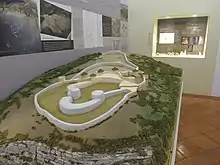
|
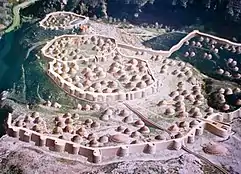
The Bell Beaker phenomenon in the Iberian Peninsula defines the late phase of the local Chalcolithic and even intrudes in the earliest centuries of the Bronze Age.[52] A review of radiocarbon dates for Bell Beaker across Europe found that some of the earliest were found in Portugal, where the range from Zambujal and Cerro de la Virgen (Spain) ran c. 2900–2500 BC, in contrast to the rather later range for Andalusia (c. 2500–2200 BC).[53]
At present, no internal chronology for the various Bell Beaker-related styles has been achieved yet for Iberia.[54] Peninsular corded Bell Beakers are usually found in coastal or near coastal regions in three main regions: the western Pyrenees, the lower Ebro and adjacent east coast, and the northwest (Galicia and northern Portugal).[55] A corded-zoned Maritime variety (C/ZM), proposed to be a hybrid between AOC and Maritime Herringbone, was mainly found in burial contexts and expanded westward, especially along the mountain systems of the Meseta.
With some notable exceptions, most Iberian early Bell Beaker "burials" are at or near the coastal regions. As for the settlements and monuments within the Iberian context, Beaker pottery is generally found in association with local Chalcolithic material and appears most of all as an "intrusion" from the third millennium in burial monuments whose origin may go back to the fourth or fifth millennia BC.
Very early dates for Bell Beakers were found in Castelo Velho de Freixo de Numão in Guarda, northern Portugal. The site was located on the summit of a spur. A short-lived first occupation of pre-Bell Beaker building phase about 3000 BC revealed the remains of a tower, some pavings, and structures for burning. After a break of one or two centuries, Bell Beaker pottery was introduced in a second building phase that lasted to the Early Bronze Age, about 1800 BC. A third building phase followed directly and lasted to about 1300 BC, after which the site was covered with layers of stone and clay, apparently deliberately, and abandoned.
The second building phase was dominated by a highly coherent group of pottery within the regional Chalcolithic styles, representing Maritime Bell Beakers of the local (northern Portuguese), penteada decoration style in various patterns, using lines of points, incision or impression. Three of them were carbon dated to the first half of the third millennium BC. The site demonstrates a notable absence of more common Bell Beaker pottery styles such as Maritime Herringbone and Maritime Lined varieties found in nearby sites such as Castanheiro do Vento and Crasto de Palheiros. One non-local Bell Beaker sherd, however, belonging to the upper part of a beaker with a curved neck and thin walls, was found at the bedrock base of this second phase. The technique and patterning are classic forms in the context of pure European and Peninsular corded ware. In the Iberian Peninsula, this AOC type was traditionally restricted to half a dozen scattered sites in the western Pyrenees, the lower Ebro, and the Spanish east coast; especially a vessel at Filomena at Villarreal, Castellón (Spain), has parallels with the decoration. In Porto Torrão, at inner Alentejo (southern Portugal), a similar vessel was found having a date ultimately corrected to around 2823–2658 BC. All pottery was locally made. The lack or presence of Bell Beaker elements is the basis for the division of Los Millares and Vila Nova cultures into two periods: I and II.
|
Balearic Islands
Radiocarbon dating currently indicates a 1,200-year duration for the use of the Beaker pottery on the Balearic Islands, between about 2475 and 1300 BC.[57] Some evidence exists of all-corded pottery in Mallorca, generally considered the most ancient Bell Beaker pottery, possibly indicating an even earlier Beaker settlement about 2700 BC.[58] However, in several regions, this type of pottery persisted long enough to permit other possibilities. Suárez Otero (1997) postulated this corded Beakers entered the Mediterranean by routes both through the Atlantic coast and eastern France. Bell Beaker pottery has been found in Mallorca and Formentera, but has not been observed in Menorca or Ibiza. Collective burials in dolmen structures in Ibiza could be contrasted against the individual burials in Mallorca. In its latest phase (about 1750–1300 cal BC) the local Beaker context became associated with the distinctive ornamented Boquique pottery[59] demonstrating clear maritime links with the (megalithic) coastal regions of Catalonia, also assessed to be directly related to the late Cogotas complex. In most of the areas of the mainland, Boquique pottery falls into the latter stages of the Bell Beaker complex, as well. Along with other evidence during the earlier Beaker period in the Balearics, c. 2400–2000 BC, as shown by the local presence of elephant ivory objects together with significant Beaker pottery and other finds,[60] this maritime interaction can be shown to have a long tradition. The abundance of different cultural elements that persisted towards the end of the Bronze Age, show a clear continuity of different regional and intrusive traditions.
The presence of perforated Beaker pottery, traditionally considered to be used for making cheese, at Son Ferrandell-Oleza [61] and at Coval Simó [62] confirms the introduction of production and conservation of dairy. Also, the presence of spindles at sites like Son Ferrandell-Oleza [63] or Es Velar d’Aprop [64] point to knowledge of making thread and textiles from wool. However, more details on the strategies for tending and slaughtering the domestic animals involved are forthcoming. Being traditionally associated with the introduction of metallurgy, the first traces of copper working in the Balearics were also clearly associated with Bell Beakers.
Central Europe

|
In their large-scale study on radiocarbon dating of the Bell Beakers, J. Müller and S. Willingen established that the Bell Beaker Culture in Central Europe started after 2500 BC.[53] Two great coexisting and separate Central European cultures – the Corded Ware with its regional groups and the Eastern Group of the Bell Beaker Culture – form the background to the Late Copper Age and Early Bronze Age. The Makó/Kosihy-Caka culture, indigenous to the Carpathians, may be included as a third component.[67] Their development, diffusion and long range changes are determined by the great river systems.
The Bell Beaker settlements are still little known, and have proved remarkably difficult for archaeologists to identify. This allows a modern view of them to contradict results of anthropologic research.[42] The late 20th century view is that the Bell Beaker people, far from being the "warlike invaders" as once described by Gordon Childe (1940), added rather than replaced local late Neolithic traditions into a cultural package and as such did not always and evenly abandon all local traditions.[68] More recent extensive DNA evidence, however, suggests a significant replacement of earlier populations.[69]
Bell Beaker domestic ware has no predecessors in Bohemia and Southern Germany, shows no genetic relation to the local Late Copper Age Corded Ware, nor to other cultures in the area, and is considered something completely new. The Bell Beaker domestic ware of Southern Germany is not as closely related to the Corded Ware as would be indicated by their burial rites. Settlements link the Southern German Bell Beaker culture to the seven regional provinces of the Eastern Group, represented by many settlement traces, especially from Moravia and the Hungarian Bell Beaker-Csepel group being the most important. In 2002, one of the largest Bell Beaker cemeteries in Central Europe was discovered at Hoštice za Hanou (Moravia, Czech Republic).[70]
The relationship to the western Bell Beakers groups, and the contemporary cultures of the Carpathian basin to the south east, is much less.[71] Research in northern Poland shifted the north-eastern frontier of this complex to the western parts of the Baltic with the adjacent Northern European plain. Typical Bell Beaker fragments from the site of Ostrikovac-Djura at the Serbian river Morava were presented at the Riva del Garda conference in 1998, some 100 km south-east of the Csepel Beaker sub-group (modern Hungary). Bell Beaker related material has now been uncovered in a line from the Baltic Sea down to the Adriatic and the Ionian Sea, including the modern states comprising Belarus, Poland, Romania, Serbia, Montenegro, Croatia, Albania, North Macedonia and parts of Greece.[72]
The Bell Beaker culture settlements in southern Germany and in the East-Group show evidence of mixed farming and animal husbandry, and indicators such as millstones and spindle whorls prove the sedentary character of the Bell Beaker people, and the durability of their settlements.[71] Some especially well equipped child-burials seem to indicate sense of predestined social position, indicating a socially complex society. However, analysis of grave furnishing, size and deepness of grave pits, position within the cemetery, did not lead to any strong conclusions on the social divisions.
The Late Copper Age is regarded as a continuous culture system connecting the Upper Rhine valley to the western edge of the Carpathian Basin. Late Copper Age 1 was defined in southern Germany by the connection of the late Cham Culture, Globular Amphora culture, and the older Corded Ware Culture of "beaker group 1" that is also referred to as Horizon A or Step A. Early Bell Beaker Culture intruded[29] into the region at the end of the Late Copper Age 1, around 2600–2550 BC. Middle Bell Beaker corresponds to Late Copper Age 2 and here an east–west Bell Beaker cultural gradient became visible through the difference in the distribution of the groups of beakers with and without handles, cups and bowls, in the three regions Austria–Western Hungary, the Danube catchment area of Southern Germany, and the Upper Rhine/lake Constance/Eastern Switzerland area for all subsequent Bell Beaker periods.[73] This middle Bell Beaker Culture is the main period when almost all the cemeteries in Southern Germany begin. Younger Bell Beaker Culture of Early Bronze Age shows analogies to the Proto-Únětice Culture in Moravia and the Early Nagyrév Culture of the Carpathian Basin.
During the Bell Beaker period, a border ran through southern Germany, which culturally divided a northern from a southern area. The northern area was oriented around the Rhine and the Bell Beaker West Group, while the southern area occupied much of the Danube river system and was mainly settled by the homogeneous Bell Beaker East Group. This latter group overlapped with the Corded Ware Culture and other groups of the Late Neolithic and early Bronze Age. Nevertheless, southern Germany shows some independent developments of itself.[29] Although a broadly parallel evolution with early, middle, and younger Bell Beaker Culture was detected, the Southern Germany middle Bell Beaker development of metope decorations and stamp and furrow engraving techniques do not appear on beakers in Austria-Western Hungary, and handled beakers are completely absent. It is contemporary to Corded Ware in the vicinity, that has been attested by associated finds of middle Corded Ware (chronologically referred to as "beaker group 2" or Step B) and younger Geiselgasteig Corded Ware beakers ("beaker group 3" or Step C). Bell Beaker Culture in Bavaria used a specific type of copper, which is characterised by combinations of trace elements. This same type of copper was spread over the area of the Bell Beaker East Group.
Previously some archaeologists considered the Bell-beaker people to have lived only within a limited territory of the Carpathian Basin and for a short time, without mixing with the local population. Although there are very few evaluable anthropological finds, the appearance of the characteristic planoccipital (flattened back) Taurid type in the populations of some later cultures (e.g. Kisapostag and Gáta–Wieselburg cultures) suggested a mixture with the local population contradicting such archaeological theories. According to archaeology, the populational groups of the Bell-beakers also took part in the formation of the Gáta-Wieselburg culture on the western fringes of the Carpathian Basin, which could be confirmed with the anthropological Bell Beaker series in Moravia and Germany.[42] In accordance with anthropological evidence, it has been concluded the Bell Beakers intruded in an already established form the southern part of Germany as much as the East Group area.[29]
Ireland
Beakers arrived in Ireland around 2500 BC and fell out of use around 1700 BC.[78] The beaker pottery of Ireland was rarely used as a grave good, but is often found in domestic assemblages from the period. This stands in contrast to the rest of Europe where it is frequently found in both roles. The inhabitants of Ireland used food vessels as a grave good instead. The large, communal passage tombs of the Irish Neolithic were no longer being constructed during the Early Bronze Age (although some, such as Newgrange were re-used[79]). The preferred method of burial seems to have been single graves and cists in the east, or in small wedge tombs in the west. Cremation was also common.
The advent of the Bronze Age Beaker culture in Ireland is accompanied by the destruction of smaller satellite tombs at Knowth[80] and collapses of the great cairn at Newgrange,[81] marking an end to the Neolithic culture of megalithic passage tombs.
Beakers are found in large numbers in Ireland, and the technical innovation of ring-built pottery indicates that the makers were also present.[82] Classification of pottery in Ireland and Britain has distinguished a total of seven intrusive[83] beaker groups originating from the continent and three groups of purely insular character having evolved from them. Five out of seven of the intrusive Beaker groups also appear in Ireland: the European bell group, the All-over cord beakers, the Scottish/North Rhine beakers, the Northern British/Middle Rhine beakers and the Wessex/Middle Rhine beakers. However, many of the features or innovations of Beaker society in Britain never reached Ireland.[84] Instead, quite different customs predominated in the Irish record that were apparently influenced by the traditions of the earlier inhabitants.[85] Some features that are found elsewhere in association to later types[86] of Earlier Bronze Age Beaker pottery, indeed spread to Ireland, however, without being incorporated into the same close and specific association of Irish Beaker context.[87] The Wessex/Middle Rhine gold discs bearing "wheel and cross" motifs that were probably sewn to garments, presumably to indicate status and reminiscent of racquet headed pins found in Eastern Europe,[88] enjoy a general distribution throughout the country, however, never in direct association with beakers.
In 1984, a Beaker period copper dagger blade was recovered from the Sillees River near Ross Lough, County Fermanagh, Northern Ireland.[89] The flat, triangular-shaped copper blade was 171 mm (6.73 in) long, with bevelled edges and a pointed tip, and featured an integral tang that accepted a riveted handle.[89] Flint arrow-heads and copper-blade daggers with handle tangs, found in association with Beaker pottery in many other parts of Europe, have a date later than the initial phase of Beaker People activity in Ireland.[90] Also the typical Beaker wristguards seem to have entered Ireland by cultural diffusion only, after the first intrusions, and unlike English and Continental Beaker burials never made it to the graves. The same lack of typical Beaker association applies to the about thirty found stone battle axes. A gold ornament found in County Down that closely resembles a pair of ear-rings from Ermegeira, Portugal, has a composition that suggests it was imported.[90] Incidental finds suggest links to non-British Beaker territories, like a fragment of a bronze blade in County Londonderry that has been likened to the "palmella" points of Iberia,[83] even though the relative scarcity of beakers, and Beaker-compatible material of any kind, in the south-west are regarded as an obstacle to any colonisation directly from Iberia, or even from France.[83] Their greater concentration in the northern part of the country,[82] which traditionally is regarded as the part of Ireland least blessed with sources of copper, has led many authorities to question the role of Beaker People in the introduction of metallurgy to Ireland. However, indications of their use of stream sediment copper, low in traces of lead and arsenic, and Beaker finds connected to mining and metalworking at Ross Island, County Kerry, provide an escape to such doubts.[91]
The featured "food vessels" and cinerary urns (encrusted, collared and cordoned) of the Irish Earlier Bronze Age have strong roots in the western European Beaker tradition. Recently, the concept of these food vessels was discarded and replaced by a concept of two different traditions that rely on typology: the bowl tradition and the vase tradition, the bowl tradition being the oldest[92] as it has been found inserted in existing Neolithic (pre-beaker) tombs, both court tombs and passage tombs. The bowl tradition occurs over the whole country except the south-west and feature a majority of pit graves, both in flat cemeteries and mounds, and a high incidence of uncremated skeletons, often in crouched position.[93] The vase tradition has a general distribution and feature almost exclusively cremation. The flexed skeleton of a man 1.88 meters tall in a cist in a slightly oval round cairn with "food vessel" at Cornaclery, County Londonderry, was described in the 1942 excavation report as "typifying the race of Beaker Folk",[94] although the differences between Irish finds and e.g. the British combination of "round barrows with crouched, unburnt burials" make it difficult to establishes the exact nature of the Beaker People's colonization of Ireland.[84]
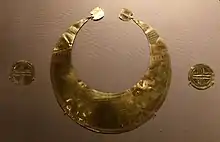
In general, the early Irish Beaker intrusions don't attest[96] the overall "Beaker package" of innovations that, once fully developed, swept Europe elsewhere, leaving Ireland behind.[97] The Irish Beaker period is characterised by the earliness[90] of Beaker intrusions, by isolation[90] and by influences and surviving traditions of autochthons.[98]
Beaker culture introduces the practice of burial in single graves, suggesting an Earlier Bronze Age social organisation of family groups.[99] Towards the Later Bronze Age the sites move to potentially fortifiable hilltops, suggesting a more "clan"-type structure.[100] Although the typical Bell Beaker practice of crouched burial has been observed,[101] cremation was readily adopted[102] in accordance with the previous tradition of the autochthons.[80] In a tumulus the find of the extended skeleton of a woman accompanied by the remains of a red deer and a small seven-year-old stallion is noteworthy, including the hint to a Diana-like religion.[103] A few burials seem to indicate social status, though in other contexts an emphasis to special skills is more likely.[104]
Ireland has the greatest concentration of gold lunulae and stone wrist-guards in Europe. However, neither of these items were deposited in graves and they tend to be found isolated and at random, making it difficult to draw conclusions about their use or role in society at the time.
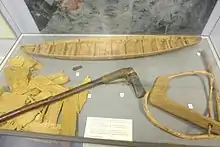
In some cases lunulae have been found with pairs of gold discs, e.g at Coggalbeg in Ireland and Cabeceiras de Basto in Portugal. Both lunulae and discs have been linked to sun worship.[105] Cahill (2015) connects them to a "great solar cult" stretching across western and central Europe to Scandinavia.[106] Cahill suggests that the central part of the lununae (which is left undecorated) represents a solar boat, which she compares to the gold boat depicted on the Nebra sky disc and to depictions of solar boats from the Nordic Bronze Age, as well as to depictions on pottery from Los Millares in Spain. Pairs of gold discs found with lunulae may therefore represent "the day and night sun", symbolising the movement of the sun from day to night and from east to west.[107] The double-sun motif has also been linked to the mythological Divine Twins,[108][109] as have ritual depositions of twinned objects, including two swords buried with the Nebra sky disc.[110] Scientific analyses have shown that gold used to make both the Irish lunulae and the Nebra sky disc originated from Cornwall, providing a further link between these artefacts.[111][112] Cornwall was also the likely source of gold used to make artefacts from the Bush Barrow at Stonehenge.[113]
One of the most important sites in Ireland during the Beaker period is Ross Island. A series of copper mines from here are the earliest known in Ireland, starting from around 2500 BC (O'Brien 2004). A comparison of chemical traces and lead isotope analysis from these mines with copper artefacts strongly suggests that Ross Island was the sole source of copper in Ireland between the dates 2500–2200 BC. In addition, two thirds of copper artefacts from Britain also display the same chemical and isotopic signature, strongly suggesting that Irish copper was a major export to Britain.[114] Traces of Ross Island copper can be found even further afield; in the Netherlands it makes up 12% of analysed copper artefacts, and Brittany 6% of analysed copper artefacts[115] After 2200 BC there is greater chemical variation in British and Irish copper artefacts, which tallies well with the appearance of other mines in southern Ireland and north Wales. After 2000 BC, other copper sources supersede Ross Island. The latest workings from the Ross Island mines is dated to around 1700 BC.
As well as exporting raw copper/bronze, there were some technical and cultural developments in Ireland that had an important impact on other areas of Europe. Irish food vessels were adopted in northern Britain around 2200 BC and this roughly coincides with a decline in the use of beakers in Britain.[78] The 'bronze halberd' (not to be confused with the medieval halberd) was a weapon in use in Ireland from around 2400–2000 BC.[78] They are essentially broad blades that were mounted horizontally on a meter long handle, giving greater reach and impact than any known contemporary weapon.[116] They were subsequently widely adopted in other parts of Europe,[117] possibly showing a change in the technology of warfare.[118]
Britain

|
Beakers arrived in Britain around 2500 BC, with migrations of Yamnaya or Corded Ware-related people, resulting in a near total turnover of the British population.[122] The Beaker-culture declined in use around 2200–2100 BC with the emergence of food vessels and cinerary urns and finally fell out of use around 1700 BC.[78] The earliest British beakers were similar to those from the Rhine,[123] but later styles are most similar to those from Ireland.[124] In Britain, domestic assemblages from this period are very rare, making it hard to draw conclusions about many aspects of society. Most British beakers come from funerary contexts.
Britain's only unique export in this period is thought to be tin. It was probably gathered in streams in Cornwall and Devon as cassiterite pebbles and traded in this raw, unrefined state.[125] It was used to turn copper into bronze from around 2200 BC and widely traded throughout Britain and into Ireland. Other possible European sources of tin are located in Brittany and Iberia, but it is not thought they were exploited so early as these areas did not have bronze until after it was well established in Britain and Ireland.[126]
The most famous site in Britain from this period is Stonehenge, which had its Neolithic form elaborated extensively. Many barrows surround it and an unusual number of 'rich' burials can be found nearby, such as the Amesbury Archer and the later Bush Barrow.
Silbury Hill was also built in the early Bell Beaker period, c. 2470–2350 BC.[127] It may have been built as a burial mound, though this has never been proven.[128][129] Bayliss et al. (2007) state that the "aggrandisement" of both Stonehenge and Silbury Hill occurred "in close relation to the appearance of novel material culture and practices" introduced by Beaker people.[130] According to Mike Parker Pearson a significantly higher level of labour mobilisation was achieved following the arrival of Beaker people in Britain.[131] The amount of effort that went into building Silbury Hill "was massively more than Stonehenge ... and its dates coincide exactly with the appearance of Beaker burials in Britain."[132] Beaker people also introduced mummification,[133] burial in log coffins[134] and cranial deformation to Britain.[135]
Another site of particular interest is Ferriby on the Humber Estuary, where western Europe's oldest sewn-plank boats were recovered, dating to as early as c. 2000 BC.[136] A later example is the Dover Boat, dating from 1550 BC.
Italian Peninsula
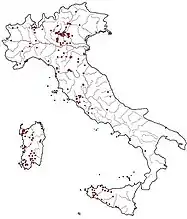
The Italian Peninsula's most affected areas are the Po Valley, in particular the area of Lake Garda, and Tuscany. The bell-shaped vases appear in these areas of central and northern Italy as "foreign elements" integrated in the pre-existing Remedello and Rinaldone cultures.[137]
Graves with Beaker artefacts have been discovered in the Brescia area, like that of Ca' di Marco (Fiesse), while in central Italy, bell-shaped glasses were found in the tomb of Fosso Conicchio (Viterbo).[138]
Sardinia
Sardinia has been in contact with extra-insular communities in Corsica, Tuscany, Liguria and Provence since the Stone Age. From the late third millennium BC on, comb-impressed Beaker ware, as well as other Beaker material in Monte Claro contexts, has been found (mostly in burials, such as Domus de Janas), demonstrating continuing relationships with the western Mediterranean. Elsewhere, Beaker material has been found stratigraphically above Monte Claro and at the end of the Chalcolithic period in association with the related Bronze Age Bonnanaro culture (1800–1600 BC), for which C-14 dates calibrate to c. 2250 BC. There is virtually no evidence in Sardinia of external contacts in the early second millennia, apart from late Beakers and close parallels between Bonnannaro pottery and that of the North Italian Polada culture.
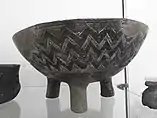
Like elsewhere in Europe and in the Mediterranean area, the Bell Beaker culture in Sardinia (2100–1800 BC) is characterised by the typical ceramics decorated with overlaid horizontal bands and associated finds: brassards, V-pierced buttons etc.; for the first time gold items appeared on the island (collier of the Tomb of Bingia 'e Monti, Gonnostramatza). The different styles and decorations of the ceramics which succeed through the time allow to split the Beaker culture in Sardinia into three chronological phases: A1 (2100–2000 BC), A2 (2000–1900 BC), B (1900–1800 BC).[139] In these various phases is observable the succession of two components of different geographical origin: the first "Franco-Iberian" and the second "Central European".[140]
It appears likely that Sardinia was the intermediary that brought Beaker materials to Sicily.[141]
Sicily
The Beaker was introduced in Sicily from Sardinia and spread mainly in the north-west and south-west of the island. In the northwest and in the Palermo kept almost intact its cultural and social characteristics, while in the south-west there was a strong integration with local cultures.[142] The only known single bell-shaped glass in eastern Sicily was found in Syracuse.[142]
Jutland
In Denmark, large areas of forested land were cleared to be used for pasture and the growing of cereals during the Single Grave culture and in the Late Neolithic Period. Faint traces of Bell Beaker influence can be recognised already in the pottery of the Upper Grave phase of the Single Grave period, and even of the late Ground Grave phase, such as occasional use of AOO-like or zoned decoration and other typical ornamentation, while Bell Beaker associated objects such as wristguards and small copper trinkets, also found their way into this northern territories of the Corded Ware Culture. Domestic sites with Beakers only appear 200–300 years after the first appearance of Bell Beakers in Europe, at the early part of the Danish Late Neolithic Period (LN I) starting at 2350 BC. These sites are concentrated in northern Jutland around the Limfjord and on the Djursland peninsula, largely contemporary to the local Upper Grave Period. In east central Sweden and western Sweden, barbed wire decoration characterised the period 2460–1990 BC, linked to another Beaker derivation of northwestern Europe.
Stone and copper arms trade
Northern Jutland has abundant sources of high quality flint, which had previously attracted industrious mining, large-scale production, and the comprehensive exchange of flint objects: notably axes and chisels. The Danish Beaker period, however, was characterised by the manufacture of lanceolate flint daggers, described as a completely new material form without local antecedents in flint and clearly related to the style of daggers circulating elsewhere in Beaker dominated Europe. Presumably Beaker culture spread from here to the remainder of Denmark, and to other regions in Scandinavia and northern Germany as well. Central and eastern Denmark adopted this dagger fashion and, to a limited degree, also archer's equipment characteristic to Beaker culture, although here Beaker pottery remained less common.
Also, the spread of metallurgy in Denmark is intimately related to the Beaker representation in northern Jutland. The LN I metalwork is distributed throughout most of Denmark, but a concentration of early copper and gold coincides with this core region, hence suggesting a connection between Beakers and the introduction of metallurgy. Most LN I metal objects are distinctly influenced by the western European Beaker metal industry, gold sheet ornaments and copper flat axes being the predominant metal objects. The LN I copper flat axes divide into As-Sb-Ni copper, recalling so-called Dutch Bell Beaker copper and the As-Ni copper found occasionally in British and Irish Beaker contexts, the mining region of Dutch Bell Beaker copper being perhaps Brittany; and the Early Bronze Age Singen (As-Sb-Ag-Ni) and Ösenring (As-Sb-Ag) coppers having a central European – probably Alpine – origin.
Connections with other parts of Beaker culture
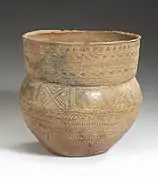
The Beaker group in northern Jutland forms an integrated part of the western European Beaker Culture, while western Jutland provided a link between the Lower Rhine area and northern Jutland. The local fine-ware pottery of Beaker derivation reveal links with other Beaker regions in western Europe, most specifically the Veluwe group at the Lower Rhine. Concurrent introduction of metallurgy shows that some people must have crossed cultural boundaries. Danish Beakers are contemporary with the earliest Early Bronze Age (EBA) of the East Group of Bell Beakers in central Europe, and with the floruit of Beaker cultures of the West Group in western Europe. The latter comprise Veluwe and Epi-Maritime in Continental northwestern Europe and the Middle Style Beakers (Style 2) in insular western Europe.
The interaction between the Beaker groups on the Veluwe Plain and in Jutland must, at least initially, have been quite intensive. All-over ornamented (AOO) and All-over-corded (AOC), and particularly Maritime style beakers are featured, although from a fairly late context and possibly rather of Epi-maritime style, equivalent to the situation in the north of the Netherlands, where Maritime ornamentation continued after it ceased in the central region of Veluwe and were succeeded c. 2300 BC by beakers of the Veluwe and Epi-Maritime style.[23]
Clusters of Late Neolithic Beaker presence similar to northern Jutland appear as pockets or "islands" of Beaker Culture in northern Europe, such as Mecklenburg, Schleswig-Holstein, and southern Norway.[143][144][145][146][147] In northern central Poland Beaker-like representations even occur in a contemporary EBA setting. The frequent occurrence of Beaker pottery in settlements points at a large-scaled form of social identity or cultural identity, or perhaps an ethnic identity.
Burial practices
In eastern Denmark and Scania one-person graves occur primarily in flat grave cemeteries. This is a continuation of the burial custom characterising the Scanian Battle-axe Culture, often to continue into the early Late Neolithic. Also in northern Jutland, the body of the deceased was normally arranged lying on its back in an extended position, but a typical Bell Beaker contracted position occurs occasionally. Typical to northern Jutland, however, cremations have been reported, also outside the Beaker core area, once within the context of an almost full Bell Beaker equipment.
Social transition
The introductory phase of the manufacture and use of flint daggers, around 2350 BC, must all in all be characterised as a period of social change. Apel argued that an institutionalised apprenticeship system must have existed.[148] Craftsmanship was transmitted by inheritance in certain families living in the vicinity of abundant resources of high-quality flint. Debbie Olausson's (1997) examinations indicate that flint knapping activities, particularly the manufacture of daggers, reflect a relatively low degree of craft specialisation, probably in the form of a division of labour between households.
Noteworthy was the adoption of European-style woven wool clothes kept together by pins and buttons in contrast to the earlier usage of clothing made of leather and plant fibres.[149][150] Two-aisled timber houses in Late Neolithic Denmark correspond to similar houses in southern Scandinavia and at least parts of central Scandinavia and lowland northern Germany. In Denmark, this mode of building houses is clearly rooted in a Middle Neolithic tradition. In general, Late Neolithic house building styles were shared over large areas of northern and central Europe.[151] Towards the transition to LN II some farm houses became extraordinarily large.
End of a distinct Beaker culture
The cultural concepts originally adopted from Beaker groups at the lower Rhine blended or integrated with local Late Neolithic Culture. For a while the region was set apart from central and eastern Denmark, that evidently related more closely to the early Únětice culture across the Baltic Sea. Before the turn of the millennium the typical Beaker features had gone, their total duration being 200–300 years at the most.
A similar picture of cultural integration is featured among Bell Beakers in central Europe, thus challenging previous theories of Bell Beakers as an elitist or purely super-structural phenomenon.[152][153][154][155][156] The connection with the East Group Beakers of Únětice had intensified considerably in LN II, thus triggering a new social transformation and innovations in metallurgy that would announce the actual beginning of the Northern Bronze Age.[157]
See also
- Beaker (disambiguation)
- Amesbury Archer
- Prehistoric Britain
- Prehistoric Iberia
- Bronze Age Britain
Notes
- Marija Gimbutas characterized the Bell Beaker culture complex as an amalgam of the Vučedol and Yamna culture, formed after the incursion of the Yamna people into the Vučedol milieu and the interaction of these peoples for three or four centuries, from circa 3000 BC.[16]
- See Anthrogenica, Eurogenes Blog: Hungarian Yamnaya > Bell Beakers?, for a number of maps.
References
- Bradley 2007, p. 144.
- Cunliffe 2010.
- Olalde, Iñigo; Brace, Selina; Allentoft, Morten E.; Armit, Ian; Kristiansen, Kristian; Booth, Thomas; Rohland, Nadin; Mallick, Swapan; Szécsényi-Nagy, Anna; Mittnik, Alissa; Altena, Eveline (March 2018). "The Beaker phenomenon and the genomic transformation of northwest Europe". Nature. 555 (7695): 190–196. doi:10.1038/nature25738. ISSN 1476-4687. PMC 5973796. PMID 29466337.
- The Concise Oxford Dictionary of Archaeology
- Papac, Luka, et al., (2021). "Dynamic changes in genomic and social structures in third millennium BCE central Europe", in Science Advances, Vol 7, Issue 35, 25 August 2021, Figure 4A.
- Fokkens & Nicolis 2012, p. 82.
- Doce, Elisa; von Lettow-Vorbeck, Corina, eds. (September 2014). Analysis of the Economic Foundations Supporting the Social Supremacy of the Beaker Groups: Proceedings of the XVII UISPP World Congress (1-7 September, Burgos, Spain). Archaeopress. ISBN 9781784913076.
- Lemercier, Olivier (December 2018). "Think and Act. Local Data and Global Perspectives in Bell Beaker Archaeology". Journal of Neolithic Archaeology. 20: 77–96. doi:10.12766/jna.2018S.5.
- Case 2007.
- Harrison & Heyd 2007.
- Fitzpatrick 2013, p. 44.
- Fokkens & Nicolis 2012, p. 201.
- Fokkens & Nicolis 2012, p. 200.
- Vander Linden, Marc (2006). Le phénomène campaniforme dans l'Europe du 3ème millénaire avant notre ère: Synthèse et nouvelles perspectives. British Archaeological Reports, international series, 1470 (in French). Oxford: Archaeopress. p. 33. ISBN 9781841719061.
- Johannes Muller; Martin Hinz; Markus Ullrich (2015). "6. Bell Beakers – Chronology, innovation and memory: A multivariate approach". In Maria Pilar Prieto Martinez; Laure Salanova (eds.). The Bell Beaker Transition in Europe: Mobility and local evolution during the 3rd millennium BC.
- Gimbutas, The Civilization of the Goddess: the world of Old Europe, 1991:372ff.
- Joseph Maran (2007), Seaborne Contacts between the Aegean, the Balkans and the Central Mediterranean in the 3rd Millennium BC – The Unfolding of the Mediterranean World. In: Between the Aegean and Baltic Seas: Prehistory across Borders. Proceedings of the International Conference Bronze and Early Iron Age Interconnections and Contemporary Developments between the Aegean and the Regions of the Balkan Peninsula, Central and Northern Europe, University of Zagreb, 11–14 April 2005, eds. I. Galanaki, H. Tomas, Y. Galanakis and R. Laffineur, Aegaeum 27 (2007) 3–21, note 55.
- Piguet, M.; Besse, M. (2009). "Chronology and Bell Beaker common ware". Radiocarbon. 51 (2): 817–830. doi:10.1017/S0033822200056125.
- Janusz Czebreszuk, Bell Beakers From West to East, in: Ancient Europe, 8000 B.C. to A.D. 1000: Encyclopedia of the Barbarian World
- Garrido Pena, Rafael (January 2014). "Bell Beakers in Iberia". In Almagro, M. (ed.). Iberia. Protohistory of the far west of Europe: from Neolithic to Roman conquest. Universidad de Burgos. Fundación Atapuerca. pp. 113–124. ISBN 978-84-92681-91-4.
- Jeunesse, C. 2014. "Pratiques funéraires campaniformes en Europe – Faut-il remettre en cause la dichotomie Nord-Sud ? La question de la réutilisation des sépultures monumentales dans l’Europe du 3e millénaire", in Données récentes sur les pratiques funéraires néolithiques de la Plaine du Rhin supérieur, P. Lefranc, A. Denaire and C. Jeunesse (eds.), BAR International Series 2633, 211. Oxford: Archaeopress.
- Salinova, Laure (2000). "La question du campaniforme en France et dans les Iles Anglo-Normandes". Bulletin de la Société Préhistorique Française (in French). 94 (2): 259–264. doi:10.3406/bspf.1997.10872.
- Lanting, J. N.; van der Waals, J. D. (1976). "Beaker culture relations in the Lower Rhine Basin". Glockenbechersimposion Oberried 1974. Bussum-Haarlem: Fibula-Van Dishoeck. pp. 1–80. ISBN 9789022836194.
- Needham, S. (2009). "Encompassing the Sea: "Maritories" and Bronze Age Maritime Interactions". In Clark, Peter (ed.). Bronze Age Connections: Cultural Contact in Prehistoric Europe. Oxford: Oxbow. pp. 12–37. ISBN 9781842173480.
- O'Brien, William (2004). Ross Island: Mining, Metal and Society in Early Ireland. Galway: Department of Archaeology, National University of Ireland. ISBN 9780953562039.
- Ambert, P. (2001). "La place de la métallurgie campaniforme dans la première métallurgie française". In Nicolis, Franco (ed.). Bell Beakers Today : pottery, people, culture, symbols in prehistoric Europe : proceedings of the International Colloquium Riva del Garda (Trento, Italy) 11–16 May 1998 (in French). Trento, Italy: Provincia Autonoma di Trento. pp. 577–588. ISBN 9788886602433.
- Lemercier, Olivier (2012). "The Mediterranean France beakers transition". In Fokkens, Harry; Nicolis, Franco (eds.). Background To Beakers: inquiries in regional cultural backgrounds of the Bell Beaker complex. Leiden: Sidestone. pp. 117–156. ISBN 9789088900846.
- Christian Strahm (ed.), Das Glockenbecher-Phänomen, ein Seminar, Freiburger Arch. Studien 2 (Freiburg 1995) 4-14, pp. 386–396.
- Heyd, Volker (1998). "Die Glockenbecherkultur in Süddeutschland– Zum Stand der Forschung einer Regionalprovinzentlang der Donau" [Bell Beaker Culture in Southern Germany, State of research for a regional province along the Danube]. In Benz, M.; van Willigen, S. (eds.). Some New Approaches to the Bell Beaker 'Phenomenon': Lost Paradise...?. British Archaeological Report S690 (in German). Oxford: Hadrian. pp. 87–106. ISBN 9780860549284.
- Burgess, C.; Shennan, S. (1976). "The Beaker Phenomenon: some suggestions". In Burgess, C.; Miket, R. (eds.). Settlement and economy in the third and second millennia BC: Papers delivered at a conference organised by the Department of Adult Education, University of Newcastle upon Tyne. Vol. 33. Oxford: British Archaeological Reports. pp. 309–331. ISBN 9780904531527.
- Fokkens & Nicolis 2012, p. 172.
- Lemercier, Olivier (2004). "Historical model of settling and spread of Bell Beakers Culture in the mediterranean France". In Czebreszuk, J. (ed.). Similar but Different: Bell Beakers in Europe, Poznań Symposium, Poland, 26–29 May 2002. Poznań, Poland: Adam Mickiewicz University. pp. 193–203. ISBN 9788385215257. Available from the author's web site.
- Price, T. Douglas; Grupe, Gisela; Schröter, Peter (1998). "Migration in the Bell Beaker period of central Europe". Antiquity. 72 (276): 405–411. doi:10.1017/S0003598X00086683.
- Olalde, I.; et al. (2017). "The Beaker Phenomenon And The Genomic Transformation Of Northwest Europe". Nature. 555 (7695): 190–196. Bibcode:2018Natur.555..190O. doi:10.1038/nature25738. PMC 5973796. PMID 29466337.
- García, Xavier C. (2001). "Bell Breaker". In Ember, Melvin; Peregrine, Peter Neal (eds.). Encyclopedia of Prehistory. Vol. 4: Europe. Springer. p. 24. ISBN 9780306462559.
- Sherratt, A. G. (1987). "Cups that cheered: The introduction of alcohol to prehistoric Europe". In Waldren, W.; Kennard, R. C. (eds.). Bell Beakers of the Western Mediterranean: Definition, interpretation, theory and new site data. The Oxford International Conference 1986. Oxford: British Archaeology Reports. pp. 81–114. ISBN 9780860544265.
- Doce, Elisa Guerra (2006). "Sobre la función y el significado de la cerámica campaniforme a la luz de los análisis de contenidos trabajos de prehistoria" [Function and significance of bell beaker pottery according to data from residue analyses]. Trabajos de Prehistoria (in Spanish). 63 (1): 69–84. doi:10.3989/tp.2006.v63.i1.5. ISSN 0082-5638.
- J.P. Mallory, 'The Indo-Europeanization of Atlantic Europe', in Celtic From the West 2: Rethinking the Bronze Age and the Arrival of Indo–European in Atlantic Europe, eds J. T. Koch and B. Cunliffe (Oxford, 2013), pp. 17–40
- "Almagro-Gorbea – La lengua de los Celtas y otros pueblos indoeuropeos de la península ibérica", 2001 p. 95. In Almagro-Gorbea, M., Mariné, M. and Álvarez-Sanchís, J. R. (eds) Celtas y Vettones, pp. 115–121. Ávila: Diputación Provincial de Ávila.
- Cox, Margaret; Mays, Simon (2000). Human Osteology in Archaeology and Forensic Science. London: Greenwich Medical Media. pp. 281–283. ISBN 9781841100463.
- A Test of Non-metrical Analysis as Applied to the 'Beaker Problem' – Natasha Grace Bartels, University of Albeda, Department of Anthropology, 1998
- Zoffmann, Zsuzsanna K. (2000). "Anthropological sketch of the prehistoric population of the Carpathian Basin" (PDF). Acta Biologica Szegediensis. 44 (1–4): 75–79.
- Gallagher, A.; Gunther, M. M.; Bruchhaus, H. (2009). "Population continuity, demic diffusion and Neolithic origins in central-southern Germany: The evidence from body proportions". Homo. 60 (2): 95–126. doi:10.1016/j.jchb.2008.05.006. PMID 19264304.
- Jocelyne Desideri, Europe during the Third Millennium BC and Bell Beaker Culture Phenomenon: peopling history through dental non-metric traits study (2008) Archived 26 July 2011 at the Wayback Machine.
- Lee, E.; et al. (2012). "Emerging genetic patterns of the European neolithic: Perspectives from a late neolithic bell beaker burial site in Germany". American Journal of Physical Anthropology. 148 (4): 571–579. doi:10.1002/ajpa.22074. PMID 22552938.
- Haak, Wolfgang (2 March 2015). "Massive migration from the steppe was a source for Indo-European languages in Europe". Nature. 522 (7555): 207–211. arXiv:1502.02783. Bibcode:2015Natur.522..207H. doi:10.1038/nature14317. PMC 5048219. PMID 25731166.
- Allentoft, ME (11 June 2015). "Population genomics of Bronze Age Eurasia". Nature. 522 (7555): 167–172. Bibcode:2015Natur.522..167A. doi:10.1038/nature14507. PMID 26062507. S2CID 4399103.
European Late Neolithic and Bronze Age cultures such as Corded Ware, Bell Beakers, Unetice, and the Scandinavian cultures are genetically very similar to each other... The close affinity we observe between peoples of Corded Ware and Sintashta cultures suggests similar genetic sources of the two... Among Bronze Age Europeans, the highest tolerance frequency was found in Corded Ware and the closely-related Scandinavian Bronze Age cultures... The Andronovo culture, which arose in Central Asia during the later Bronze Age, is genetically closely related to the Sintashta peoples, and clearly distinct from both Yamnaya and Afanasievo. Therefore, Andronovo represents a temporal and geographical extension of the Sintashta gene pool... There are many similarities between Sintasthta/Androvono rituals and those described in the Rig Veda and such similarities even extend as far as to the Nordic Bronze Age.
- Mathieson, Iain (24 December 2015). "Genome-wide patterns of selection in 230 ancient Eurasians". Nature. 528 (7583): 499–503. Bibcode:2015Natur.528..499M. doi:10.1038/nature16152. PMC 4918750. PMID 26595274.
- Olalde 2018.
- Papac, Luka, et al., (2021). "Dynamic changes in genomic and social structures in third millennium BCE central Europe", in Science Advances, Vol 7, Issue 35, 25 August 2021, Figure 4A.
- The Oxford Illustrated Prehistory of Europe - Barry Cunliffe, Oxford University Press (1994), pp. 250–254.
- F. Jordá Cerdá et al., Historia de España 1: Prehistoria, 1986. ISBN 842491015X.
- Müller, Johannes; van Willigen, Samuel (2001). "New radiocarbon evidence for European Bell Beakers and the consequences for the diffusion of the Bell Beaker Phenomenon". In Nicolis, Franco (ed.). Bell Beakers today: Pottery, people, culture, symbols in prehistoric Europe: Proceedings of the international colloquium Riva del Garda (Trento, Italy), 11–16 May 1998, Volume 1. Trento: Provincia Autonoma di Trento. pp. 59–80. ISBN 9788886602433.
- Jorge, Susana Oliveira (2002). "An all-over corded Bell Beaker in northern Portugal: Castelo Velho de Freixo de Numão (Vila Nova de Foz Côa): some remarks" (PDF). Journal of Iberian Archaeology. 4: 107–123. Archived from the original (PDF) on 24 January 2005.
- Prieto Martínez, M. P. (2013). "Unity and Circulation: what underlies the homogeneity of Galician bell beaker ceramic style?". In Prieto Martínez, M. Pilar; Salanova, Laure (eds.). Current researches on bell beakers : proceedings of 15th International Bell Beaker: From Atlantic to Ural, 5th-9th May 2011, Poio (Pontevedra, Galicia, Spain). Santiago de Compostela: Copynino. ISBN 9788494153709. Retrieved 4 October 2015.
- Garrido Pena, Rafael (January 2014). "Bell Beakers in Iberia". In Almagro, M. (ed.). Iberia. Protohistory of the far west of Europe: from Neolithic to Roman conquest. Universidad de Burgos. Fundación Atapuerca. pp. 113–124. ISBN 978-84-92681-91-4.
- (Waldren and Van Strydonck 1996).
- Trias, Manuel Calvo; Ayuso, Víctor M. Guerrero; Simonet, Bartomeu Salvà (2002). "Los orígenes del poblamiento balear: una discusión no acabada". Complutum (in Spanish). 13: 159–191. ISSN 1131-6993.
- Waldren, William H. (2003). "Evidence of Iberian Bronze Age 'Boquique' Pottery in the Balearic Islands: Trade, Marriage or Culture?". Oxford Journal of Archaeology. 22 (4): 357–374. doi:10.1046/j.1468-0092.2003.00193.x. Available from the author's web site.
- (Waldren 1979 and Waldren 1998),
- (Waldren 1998: 95)
- (Coll 2000),
- (Waldren 1998: 94)
- (Carreras y Covas 1984)
- O’Connor, Brendan (2010). "From Dorchester to Dieskau – some aspects of relations between Britain and Central Europe during the Early Bronze Age". In Meller, Harald; Bertemes, Francoise (eds.). Der Griff nach den Sternen - Wie Europas Eliten zu Macht und Reichtum kamen, 591-602. Halle: Tagungen des Landesmuseums für Vorgeschichte Halle.
- Pasztor, Emilia; Barna, Judit (2015). "Neolithic Longhouses and Bronze Age Houses in Central Europe". In Ruggles, CLN (ed.). Handbook of Archaeoastronomy and Ethnoastronomy. pp. 1307–1315.
- Bertemes, François; Heyd, Volker (2002). "Der Übergang Kupferzeit / Frühbronzezeit am Nordwestrand des Karpatenbeckens – Kulturgeschichtliche und paläometallurgische Betrachtungen" [The transition from the Copper Age to the Early Bronze Age at the north-western edge of the Carpathian basin culture historical and palaeometallurgical considerations]. In Bartelheim, Martin; Pernicka, Ernst; Krause, Rüdiger (eds.). Die Anfänge der Metallurgie in der alten Welt [The beginnings of metallurgy in the old world] (in German). Rahden: Verlag Marie Leidorf. pp. 185–228. ISBN 9783896468710.
- Darvill, T. (2002). "Beaker culture". Oxford Concise Dictionary of Archaeology. Oxford University Press. p. 42. ISBN 9780192116499.
- Brotherton, Paul; et al. (2013). "Neolithic mitochondrial haplogroup H genomes and the genetic origins of Europeans". Nature Communications. 4: 1764. Bibcode:2013NatCo...4.1764.. doi:10.1038/ncomms2656. PMC 3978205. PMID 23612305.
- Anthropology of skeletal remains of Bell – Beaker people from Moravia (Czech Republic)
- Heyd, V.; Husty, L.; Kreiner, L. (2004). Siedlungen der Glockenbecherkultur in Süddeutschland und Mitteleuropa [Bell Beaker settlements in South Germany and Central Europe] (in German). Büchenbach: Faustus. ISBN 9783933474278.
- The Eastern Border of the Bell Beaker-Phenomenon – Volker Heyd, 2004
- Heyd, Volker (2000). Die Spätkupferzeit in Süddeutschland [The Late Copper age in Southern Germany] (in German). Bonn: Habelt. ISBN 9783774930483.
- Spatzier, Andre; Bertemes, Francois (June 2018). "The ring sanctuary of Pömmelte, Germany: a monumental, multi-layered metaphor of the late third millennium BC". Antiquity. 92 (363): 655–673.
- "Stonehenge's Continental Cousin". Archaeology. January 2021.
- "The World of the Nebra Sky Disc". Halle State Museum of Prehistory.
- "Pair of Gold discs". A History of Ireland in 100 Objects.
- Needham, S. (1996). "Chronology and periodisation in the British Bronze Age". Acta Archaeologica. 67: 121–140.
- O'Kelly, M.J. (1982). Newgrange: Archaeology, Art and Legend. London: Thames & Hudson.
- Flanagan 1998, p. 71.
- Flanagan 1998, p. 99.
- Flanagan 1998, p. 78.
- Flanagan 1998, p. 82.
- Flanagan 1998, p. 81.
- Flanagan 1998, pp. 94–95.
- Flanagan 1998, p. 84.
- Flanagan 1998, p. 85.
- Flanagan 1998, pp. 86–88.
- Sheridan, Alison; Northover, Peter (1993). "A Beaker Period copper dagger blade from the Sillees River near Ross Lough, Co. Fermanagh". Ulster Journal of Archaeology. 3rd series. 56: 61–69. JSTOR 20568187.
- Flanagan 1998, p. 88.
- Flanagan 1998, p. 89.
- Flanagan 1998, p. 104.
- Flanagan 1998, pp. 104–105, 111–114.
- Male sizes range between 157 and 191 cm (62 and 75 in), to average 174 cm (69 in), comparable to the current male population: Flanagan 1998, p. 116
- "Coggalbeg Gold Hoard". A History of Ireland in 100 Objects. Retrieved 17 March 2021.
- Flanagan 1998, pp. 84–85, 116.
- Flanagan 1998, p. 133.
- Flanagan 1998, p. 91.
- Flanagan 1998, p. 150.
- Flanagan 1998, p. 158.
- Flanagan 1998, pp. 96, 151.
- Flanagan 1998, pp. 105–106.
- Flanagan 1998, p. 156.
- Flanagan 1998, p. 155.
- Urbanus, Jason (2015). "Bronze Age Ireland's Taste in Gold". Archaeology. Retrieved 26 April 2022.
- Cahill, Mary (Spring 2015). "'Here comes the sun....: solar symbolism in Early Bronze Age Ireland'". Archaeology Ireland. 29 (1): 26–33.
- Cahill, Mary (Spring 2015). "'Here comes the sun....: solar symbolism in Early Bronze Age Ireland'". Archaeology Ireland. 29 (1): 26–33.
- Kristiansen, Kristian (2012). "Rock Art and Religion The sun journey in Indo-European mythology and Bronze Age rock art" (PDF). Adoranten 2012: 69–86.
- Lahelma, Antti (2017). "The Circumpolar Context of the'Sun Ship' Motif in South Scandinavian Rock Art". In Skoglund, Peter; Ling, Johan; Bertilsson, Ulf (eds.). North Meets South: Theoretical Aspects on the Northern and Southern Rock Art Traditions in Scandinavia. Oxbow Books. pp. 144–171.
- Kristiansen, Kristian (2011). "Bridging India and Scandinavia: Institutional Transmission and Elite Conquest during the Bronze Age". In Wilkinson, Toby C.; Sherratt, Susan; Bennet, John (eds.). Interweaving Worlds: Systemic Interactions in Eurasia, 7th to 1st Millennia BC. Oxbow Books. pp. 243–265.
- Urbanus, Jason (2015). "Bronze Age Ireland's Taste in Gold". Archaeology. Retrieved 26 April 2022.
- Ehser, Gregor; Borg; Pernicka, Ernst (August 2011). "Provenance of the gold of the Early Bronze Age Nebra Sky Disk, central Germany: geochemical characterization of natural gold from Cornwall". European Journal of Mineralogy. 23: 895–910.
- "Where did the gold from the time of Stonehenge come from? Analysing the Bush Barrow dagger". Wiltshire Museum. 2019. Retrieved 26 April 2022.
- Northover, J.P.N.; O'Brien, W.; Stos, S. (2001). "Lead isotopes and metal circulation in Beaker/Early Bronze Age Ireland". Journal of Irish Archaeology. 10: 25–47.
- Northover, J.P. (1999). Hauptmann, A.; Pernicka, E.; Rehren, T.; Yalçin, Ü. (eds.). "The earliest metalworking in South Britain". The Beginnings of Metallurgy. Bochum: Dt. Bergbau-Museum: 211–225.
- O'Flaherty, R. (2007). "A weapon of choice: experiments with a replica Irish early Bronze Age halberd". Antiquity. 81 (312): 425–434. doi:10.1017/s0003598x00095284.
- Schuhmacher, T.X. (2002). "Some remarks on the origin and chronology of halberds in Europe". Oxford Journal of Archaeology. 21 (3): 263–288. doi:10.1111/1468-0092.00162.
- James, Simon (1993). Exploring the World of the Celts. London: Thames & Hudson. p. 21. ISBN 9780500279984.
- "wrist-guard". British Museum.
- "Gold lunula". National Museums Scotland.
- "Lunula". British Museum.
- Köljing, Cecilia (21 February 2018). "Ancient DNA reveals impact of the "Beaker Phenomenon" on prehistoric Europeans". University of Gothenburg. Archived from the original on 23 May 2019.
- Needham, S. (2005). "Transforming Beaker Culture in North-West Europe: processes of fusion and fission". Proceedings of the Prehistoric Society. 71: 171–217. doi:10.1017/s0079497x00001006.
- Case, H. (1993). "Beakers: Deconstruction and After". Proceedings of the Prehistoric Society. 59: 241–268. doi:10.1017/s0079497x00003807.
- Charles, J. A. (1975). "Where is the Tin?". Antiquity. 49 (193): 19–24. doi:10.1017/S0003598X00063201.
- Bradley 2007, p. 146.
- Armit, Ian; Reich, David (2021). "The return of the Beaker folk? Rethinking migration and population change in British prehistory". Antiquity. 95 (384): 1464–1477. doi:10.15184/aqy.2021.129.
- Harding, Anthony (2012). "The Tumulus in European Prehistory: Covering the Body, Housing the Soul". In Borgna, Elizabetta; Müller Celka, Sylvie (eds.). Ancestral Landscapes: Burial mounds in the Copper and Bronze Ages. Proceedings of the International Conference held in Udine, May 15th-18th 2008. Maison de l'Orient. p. 23. ISBN 978-2-35668-022-8.
There are cases where the practice of building a barrow could be carried to extreme lengths. The pyramids of the Old Kingdom of Egypt are essentially barrows, of a special sort; maybe Silbury Hill near Marlborough in southern England was a burial mound, though this has never been proven.
- Turek, Jan (June 2016). "The Beaker World and Otherness of the Early Civilizations". Musaica Archaeologica. 1 (1): 155–162.
on the British Isles the Bell Beaker communities have created monuments such as the late phase of construction of Stonehenge shrine or a giant burial mound of Silbury Hill, which are comparable with Egyptian temples and pyramids.
- Bayliss, Alex; McAvoy, Fachtna; Whittle, Alisdair (2007). "The world recreated: redating Silbury Hill in its monumental landscape". Antiquity. 81 (311): 26–53. doi:10.1017/S0003598X00094825.
- Mike Parker Pearson, 'The New Archaeology of Stonehenge' (2021).
- Mike Parker Pearson, 'The New Archaeology of Stonehenge' (2021).
- Smith, Allen (2016). "Holding on to the past: Southern British evidence for mummification and retention of the dead in the Chalcolithic and Bronze Age". Journal of Archaeological Science: Reports. 10: 744–756. doi:10.1016/j.jasrep.2016.05.034.
- Melton, Nigel (2015). "Gristhorpe Man: an Early Bronze Age log-coffin burial scientifically defined". Antiquity. 84 (325): 796–815. doi:10.1017/S0003598X00100237. S2CID 53412188.
- Mike Parker Pearson, 'The New Archaeology of Stonehenge' (2021).
- "Bronze Age boat 'oldest in Europe'". BBC News. Retrieved 18 March 2015.
- Le grandi avventure dell'archeologia Vol. 5: Europa e Italia protostorica – Curcio editore, pp. 1585–1586
- Il complesso culturale di "Fosso Conicchio" (Viterbo) Archived 4 March 2016 at the Wayback Machine
- Giovanni Ugas-L'alba dei Nuraghi (2005) p. 12
- Ceramiche. Storia, linguaggio e prospettive in Sardegna, Maria Rosaria Manunza, p. 26
- Piccolo, S. (2013). Ancient Stones: The Prehistoric Dolmens of Sicily. Abingdon: Brazen Head Publishing. p. 32. ISBN 9780956510624.
- Tusa, Sebastiano (1999). La Sicilia nella Preistoria, Palermo: Sellerio Editore. ISBN 8838914400 pp. 310–311
- Struve 1955, pl. 22
- Kühn 1979, pl. 11; 18
- Myhre 1978-1979
- Jacobs 1991
- Prescott & Walderhaug 1995
- Apel 2001, 42, p. 323 ff
- Bender Jørgensen 1992, p. 114
- Ebbesen 1995; 2004
- Nielsen 2000, pp. 161 ff.
- cf. Shennan 1976; 1977
- Harrison, R.J. (1980). The Beaker Folk. Thames and Hudson.
- Thorpe & Richards 1984
- Lohof 1994
- Strahm 1998
- Vandkilde, Helle (2005). "A Review of the Early Late Neolithic Period in Denmark: Practice, Identity and Connectivity" (PDF). www.jungstein.SITE.de. Retrieved 12 August 2014.
Sources
- Bradley, Richard (2007). The prehistory of Britain and Ireland. Cambridge: Cambridge University Press. ISBN 9780521848114.
- Case, Humphrey (2007). "Beakers and the Beaker Culture". In Burgess, Christopher; Topping, Peter; Lynch, Frances (eds.). Beyond Stonehenge: Essays on the Bronze Age in honour of Colin Burgess. Oxford: Oxbow. pp. 237–254. ISBN 9781842172155.
- Cunliffe, Barry (2010). Celtic from the West Chapter 1: Celticization from the West: The Contribution of Archaeology. Oxbow Books, Oxford. pp. 27–31. ISBN 9781842174104.
- Fitzpatrick, A. P. (2013). "The arrival of the Beaker Set in Britain and Ireland". In Koch, John T.; Cunliffe, Barry W. (eds.). Celtic from the West 2 : rethinking the Bronze Age and the arrival of Indo-European in Atlantic Europe. Oxford: Oxbow. p. 44. ISBN 9781842175293.
- Fokkens, Harry; Nicolis, Franco, eds. (2012). Background To Beakers: inquiries in regional cultural backgrounds of the Bell Beaker complex. Leiden: Sidestone. ISBN 9789088900846.
- Harrison, R.; Heyd, V. (2007). "The Transformation of Europe in the Third Millennium BC: the example of 'Le Petit-Chasseur I + III' (Sion, Valais, Switzerland)". Praehistorische Zeitschrift. 82 (2): 129–214. doi:10.1515/pz.2007.010. S2CID 161404297.
- Flanagan, Laurence (1998). Ancient Ireland, Life before the Celts. Dublin: Gill & MacMillan. ISBN 9780717124336.
- Olalde, I. (21 February 2018). "The Beaker phenomenon and the genomic transformation of northwest Europe". Nature. Nature Research. 555 (7695): 190–196. Bibcode:2018Natur.555..190O. doi:10.1038/nature25738. PMC 5973796. PMID 29466337.
- Piggot, Stuart (1965). Ancient Europe from the Beginnings of Agriculture to Classical Antiquity: a Survey. Chicago: Aldine.
Further reading
- Case, H. (2001). "The Beaker Culture in Britain and Ireland: Groups, European Contacts and Chronology". In Nicolis, F. (ed.). Bell Beakers Today: pottery people, culture, symbols in prehistoric Europe. Servizio Beni Culturali Ufficio Beni Archeologici. Vol. 2. Torento. pp. 361–377.
- Harding, Anthony; Fokkens, Harry (2013). The Oxford Handbook of European Bronze Age (Oxford Handbooks in Archaeology). Oxford University Press. ISBN 978-0199572861.
- Mallory J.P. (1997) "Beaker Culture". Encyclopedia of Indo-European Culture, Fitzroy Dearborn.
- Rincon, Paul (23 April 2013). "Making of Europe unlocked by DNA". BBC News.
External links
- BBC – History – Bronze Age Britain
- Historical model of settling and spread of Bell Beakers Culture in the mediterranean France
- Bell beakers from west to east
- All Bell Beaker scientific articles on line free access
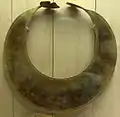



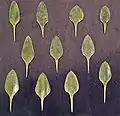

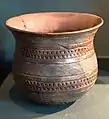
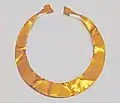
._Bell_Beaker_culture_ca._2500-2200_BC._Museum_f%C3%BCr_Vor-_und_Fr%C3%BChgeschichte%252C_Berlin.jpg.webp)



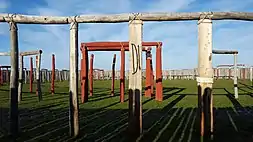
.jpg.webp)

